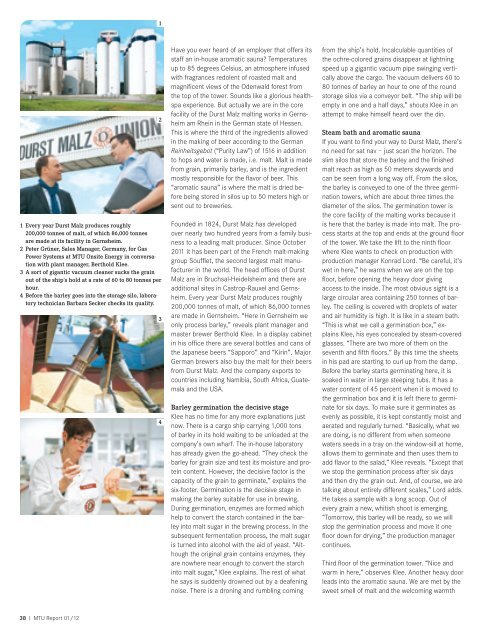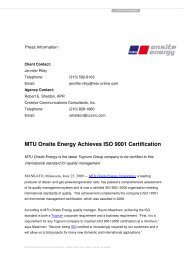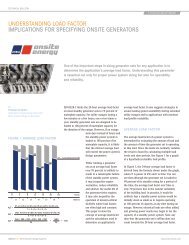English - MTU Onsite Energy
English - MTU Onsite Energy
English - MTU Onsite Energy
Create successful ePaper yourself
Turn your PDF publications into a flip-book with our unique Google optimized e-Paper software.
1<br />
1 Every year Durst Malz produces roughly<br />
200,000 tonnes of malt, of which 86,000 tonnes<br />
are made at its facility in Gernsheim.<br />
2 Peter Grüner, Sales Manager, Germany, for Gas<br />
Power Systems at <strong>MTU</strong> <strong>Onsite</strong> <strong>Energy</strong> in conversation<br />
with plant manager, Berthold Klee.<br />
3 A sort of gigantic vacuum cleaner sucks the grain<br />
out of the ship’s hold at a rate of 60 to 80 tonnes per<br />
hour.<br />
4 Before the barley goes into the storage silo, laboratory<br />
technician Barbara Secker checks its quality.<br />
2<br />
3<br />
4<br />
Have you ever heard of an employer that offers its<br />
staff an in-house aromatic sauna? Temperatures<br />
up to 85 degrees Celsius, an atmosphere infused<br />
with fragrances redolent of roasted malt and<br />
magnificent views of the Odenwald forest from<br />
the top of the tower. Sounds like a glorious healthspa<br />
experience. But actually we are in the core<br />
facility of the Durst Malz malting works in Gernsheim<br />
am Rhein in the German state of Hessen.<br />
This is where the third of the ingredients allowed<br />
in the making of beer according to the German<br />
Reinheitsgebot (“Purity Law”) of 1516 in addition<br />
to hops and water is made, i.e. malt. Malt is made<br />
from grain, primarily barley, and is the ingredient<br />
mostly responsible for the flavor of beer. This<br />
“aromatic sauna” is where the malt is dried before<br />
being stored in silos up to 50 meters high or<br />
sent out to breweries.<br />
Founded in 1824, Durst Malz has developed<br />
over nearly two hundred years from a family business<br />
to a leading malt producer. Since October<br />
2011 it has been part of the French malt-making<br />
group Soufflet, the second largest malt manufacturer<br />
in the world. The head offices of Durst<br />
Malz are in Bruchsal-Heidelsheim and there are<br />
additional sites in Castrop-Rauxel and Gernsheim.<br />
Every year Durst Malz produces roughly<br />
200,000 tonnes of malt, of which 86,000 tonnes<br />
are made in Gernsheim. “Here in Gernsheim we<br />
only process barley,” reveals plant manager and<br />
master brewer Berthold Klee. In a display cabinet<br />
in his office there are several bottles and cans of<br />
the Japanese beers “Sapporo” and “Kirin”. Major<br />
German brewers also buy the malt for their beers<br />
from Durst Malz. And the company exports to<br />
countries including Namibia, South Africa, Guatemala<br />
and the USA.<br />
Barley germination the decisive stage<br />
Klee has no time for any more explanations just<br />
now. There is a cargo ship carrying 1,000 tons<br />
of barley in its hold waiting to be unloaded at the<br />
company’s own wharf. The in-house laboratory<br />
has already given the go-ahead. “They check the<br />
barley for grain size and test its moisture and protein<br />
content. However, the decisive factor is the<br />
capacity of the grain to germinate,” explains the<br />
six-footer. Germination is the decisive stage in<br />
making the barley suitable for use in brewing.<br />
During germination, enzymes are formed which<br />
help to convert the starch contained in the barley<br />
into malt sugar in the brewing process. In the<br />
subsequent fermentation process, the malt sugar<br />
is turned into alcohol with the aid of yeast. “Although<br />
the original grain contains enzymes, they<br />
are nowhere near enough to convert the starch<br />
into malt sugar,” Klee explains. The rest of what<br />
he says is suddenly drowned out by a deafening<br />
noise. There is a droning and rumbling coming<br />
from the ship’s hold. Incalculable quantities of<br />
the ochre-colored grains disappear at lightning<br />
speed up a gigantic vacuum pipe swinging vertically<br />
above the cargo. The vacuum delivers 60 to<br />
80 tonnes of barley an hour to one of the round<br />
storage silos via a conveyor belt. “The ship will be<br />
empty in one and a half days,” shouts Klee in an<br />
attempt to make himself heard over the din.<br />
Steam bath and aromatic sauna<br />
If you want to find your way to Durst Malz, there’s<br />
no need for sat nav – just scan the horizon. The<br />
slim silos that store the barley and the finished<br />
malt reach as high as 50 meters skywards and<br />
can be seen from a long way off. From the silos,<br />
the barley is conveyed to one of the three germination<br />
towers, which are about three times the<br />
diameter of the silos. The germination tower is<br />
the core facility of the malting works because it<br />
is here that the barley is made into malt. The process<br />
starts at the top and ends at the ground floor<br />
of the tower. We take the lift to the ninth floor<br />
where Klee wants to check on production with<br />
production manager Konrad Lord. “Be careful, it’s<br />
wet in here,” he warns when we are on the top<br />
floor, before opening the heavy door giving<br />
access to the inside. The most obvious sight is a<br />
large circular area containing 250 tonnes of barley.<br />
The ceiling is covered with droplets of water<br />
and air humidity is high. It is like in a steam bath.<br />
“This is what we call a germination box,” explains<br />
Klee, his eyes concealed by steam-covered<br />
glasses. “There are two more of them on the<br />
seventh and fifth floors.” By this time the sheets<br />
in his pad are starting to curl up from the damp.<br />
Before the barley starts germinating here, it is<br />
soaked in water in large steeping tubs. It has a<br />
water content of 45 percent when it is moved to<br />
the germination box and it is left there to germinate<br />
for six days. To make sure it germinates as<br />
evenly as possible, it is kept constantly moist and<br />
aerated and regularly turned. “Basically, what we<br />
are doing, is no different from when someone<br />
waters seeds in a tray on the window-sill at home,<br />
allows them to germinate and then uses them to<br />
add flavor to the salad,” Klee reveals. “Except that<br />
we stop the germination process after six days<br />
and then dry the grain out. And, of course, we are<br />
talking about entirely different scales,” Lord adds.<br />
He takes a sample with a long scoop. Out of<br />
every grain a new, whitish shoot is emerging.<br />
“Tomorrow, this barley will be ready, so we will<br />
stop the germination process and move it one<br />
floor down for drying,” the production manager<br />
continues.<br />
Third floor of the germination tower. “Nice and<br />
warm in here,” observes Klee. Another heavy door<br />
leads into the aromatic sauna. We are met by the<br />
sweet smell of malt and the welcoming warmth<br />
38 I <strong>MTU</strong> Report 01/12















![Full power range of diesel generator sets [PDF] - MTU Onsite Energy](https://img.yumpu.com/28297693/1/190x253/full-power-range-of-diesel-generator-sets-pdf-mtu-onsite-energy.jpg?quality=85)
